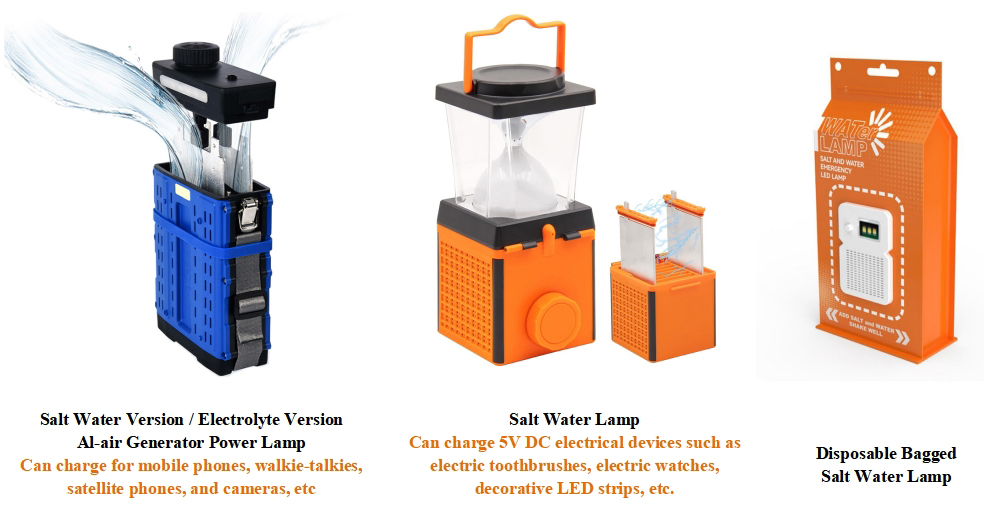A  9. Generation Mechanism of Aluminum-Air Generator Power Lamp Driven by Alkaline Electrolyte Solution and Its Characteristic Production of Soluble Potassium Aluminate” (Aluminum Plate + Electrolyte Powder + Water = Generator).
9. Generation Mechanism of Aluminum-Air Generator Power Lamp Driven by Alkaline Electrolyte Solution and Its Characteristic Production of Soluble Potassium Aluminate” (Aluminum Plate + Electrolyte Powder + Water = Generator). If saltwater is replaced with an alkaline electrolyte, the power generation principle and reaction process of the aluminum-air battery will differ. Below is a detailed analysis:
The aluminum-air battery generates electricity by using aluminum as the anode and oxygen from the air as the cathode in a potassium hydroxide (KOH) alkaline electrolyte solution through a redox reaction.
Detailed Reaction Process:
1. Anode (Aluminum Electrode): Aluminum undergoes an oxidation reaction in an alkaline environment, losing electrons and forming aluminate ions. Due to the presence of potassium hydroxide, the generated aluminate primarily exists in the form of tetrahydroxoaluminate ions [Al(OH)₄]⁻) in the solution.
Al + 4OH⁻ → [Al(OH)₄]⁻ + 3e−
2. Cathode (Air Electrode): Oxygen from the air is reduced on the cathode surface, reacting with water to form hydroxide ions (OH⁻). This process typically requires a catalyst to lower the activation energy, such as activated carbon or other non-precious metal catalysts.
O₂ + 2H₂O + 4e⁻ → 4OH⁻
3. Electrolyte (KOH Solution): The potassium hydroxide solution provides a high concentration of hydroxide ions, promoting the oxidation of aluminum and the reduction of oxygen. Simultaneously, it acts as an ionic conductor, maintaining charge balance within the battery.
4. Overall Reaction: Combining the anode and cathode reactions gives the overall reaction equation. To balance the charges and number of atoms, it is usually based on 4 aluminum atoms:
4Al + 3O₂ + 6H₂O + 4KOH → 4K[Al(OH)₄]
Or written in ionic form:
4Al + 3O₂ + 6H₂O + 4OH⁻ → 4[Al(OH)₄]⁻
5. Reaction Products: The main product of the reaction is potassium tetrahydroxoaluminate (K[Al(OH)₄]), which dissolves in the KOH solution. In some cases, if the solution is oversaturated, aluminum hydroxide (Al(OH)₃) precipitate may form.
A dditional Notes:
Passivation Film: In non-alkaline or weakly alkaline environments, an oxide film easily forms on the aluminum surface, hindering the reaction. However, in high-concentration KOH solutions, this oxide film is dissolved, ensuring that aluminum can continue to oxidize.
Hydrogen Evolution Reaction (HER): Under alkaline conditions, aluminum may also undergo a hydrogen evolution reaction, which is a side reaction that reduces the efficiency of the battery.
2Al + 6H₂O + 2OH⁻ → 2[Al(OH)₄]⁻ + 3H₂
To suppress the hydrogen evolution reaction, some alloying elements or inhibitors are usually added.
Practical Applications: Aluminum-air batteries have a very high theoretical energy density, but practical applications are affected by various factors, such as the concentration of the electrolyte, temperature, and current density.
Summary:
The battery generates electrical energy through the oxidation of aluminum and the reduction of oxygen, with the final product primarily being potassium tetrahydroxoaluminate
K[Al(OH)₄] dissolved in the electrolyte.
In Electrolyte Powder Potassium Hydroxide KOH) Solution, the Reaction Principle is as Follows: | Step | Equation | Explanation |
|
| Anode (Main) | Al + 4OH⁻ → [Al(OH)₄]⁻ + 3e⁻ | Aluminum oxidation |
|
| Cathode (Main) | O₂ + 2H₂O + 4e⁻ → 4OH⁻ | Oxygen reduction |
|
| Al3⁺Precipitation | 4Al + 3O₂ + 6H₂O + 4OH⁻ → 4[Al(OH)₄]⁻ | Al3⁺Precipitation |
|
| Overall reaction | 4Al + 3O₂ + 6H₂O + 4KOH → 4K[Al(OH)₄] or 4Al + 3O₂ + 6H₂O + 4KOH → 4KAlO₂ ⋅xH2O | Final products of the main reaction are water-soluble 4K[Al(OH)₄] or KAlO₂ |
|
| Anode Side Reaction | 2Al + 6H₂O → 2Al(OH)₃↓ + 3H₂↑ | Hydrogen evolution |
|
Stopping Use for More Than 2 Hours
If you won't be using the lamp for more than 2 hours, pour out the electrolyte or saltwater to completely stop the electrochemical reaction, This helps prevent unnecessary power loss.
Daily check for Flowability
Monitor the aluminum hydroxide inside the lamp, lf the solid particles stop flowing smoothly, pour out the old solution and replace it with fresh electrolyte or saltwater, lf left too long, the particles may harden, making cleaning difficult.
Long-Term Storage
Before storing the lamp, empty the electrolyte solution or saltwater, clean the battery compartment and electrode plates, and keep them dry. This prevents damage and keeps your lamp in good condition for future use.
⚠ Warning:
Check Electrolyte Fluidity Regularly ⚠
Using the
Aluminum-Air Generator for More Than 8 Hours: If you need to use the generator continuously for more than 8 hours, there are two options. First, as you approach the 8-hour mark, check the liquid level in the chambers to ensure it still fully submerges the electrode plates. If the water level has dropped, add a small amount of water as needed. If water is not available and you need to keep using the generator, open the top threaded cap to help dissipate heat. This will prevent overheating and ensure stable performance.
Check Saltwater Fluidity Regularly ⚠
The fluidity of the saltwater should be checked every 4-6 hours, depending on the power consumption of the connected device.
❌ If the liquid becomes thick or less fluid, it can affect performance.
✅ To ensure optimal operation, clean and replace it with fresh saltwater immediately if needed.

To be continued Part 3
English
العربية
Français
Русский
Español
Português
Deutsch
italiano
日本語
한국어
Nederlands
Tiếng Việt
ไทย
Polski
Türkçe
አማርኛ
ພາສາລາວ
ភាសាខ្មែរ
Bahasa Melayu
ဗမာစာ
தமிழ்
Filipino
Bahasa Indonesia
magyar
Română
Čeština
Монгол
қазақ
Српски
हिन्दी
فارسی
Kiswahili
Slovenčina
Slovenščina
Norsk
Svenska
українська
Ελληνικά
Suomi
Հայերեն
עברית
اردو
Afrikaans
Gaeilge
नेपाली
Aymara
Беларуская мова
guarani
Krio we dɛn kɔl Krio
Runasimi
Wikang Tagalog
















